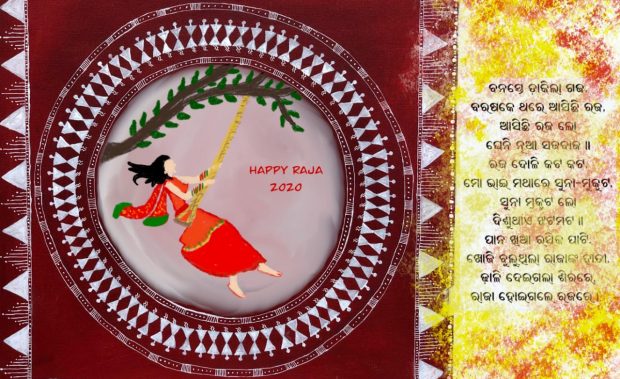Raja Parva or Raja Festival is celebrated in the state of Odisha in the middle of June every year. The word Raja is derived from a Sanskrit word “Rajaswala”, which means a menstruating woman.

It is a three-day-long celebration of menstruation and womanhood. It is believed that the Earth Goddess (Bhudevi or Basumati), the consort of Lord Jagannatha (Vishnu), undergoes menstruation during these three days. The fourth
day is considered as the purification bath and is known as the “Basumati Snnana” or the “Ceremonial Bath of Bhudevi”. To give respect towards Mother Earth (Bhudevi), all agricultural jobs, such as plowing, sowing, fertilizing, and irrigating, are halted for these three days.
The main idea is not to hurt Mother Earth during this time. It signifies the menstrual cycle of the earth similar to that of a woman. Just like women go into a resting phase during “periods”, the earth is considered to be in a latent stage.
The first day of the festival is called “Pahili Raja”, the second is called “Raja Sankranti” or “Mithuna Sankranti”, and the third is called “Basi Raja” or “Bhu Daaha”. Prior to the Pahili Raja is a preparatory day and is called “Saja Baja”.
Normally in houses in Odia villages, especially in the kitchen, grinding stones are cleaned. Women cook food prior to Raja and keep it for three days because they have to take rest for these three days as per ritual. The fourth day is called “Basumati Snnana”, in which the women bathe the grinding stone as a symbol of Bhumi (mother earth) by applying turmeric paste on it and adorning it with different types of flowers and sindoor (red-colored traditional vermilion) powder and different types of fruits available at that time.
During this festival, women and girls wear new dresses or saree, Alata (red-colored liquid used to apply on the feet for beautification), flowers, ornaments, and decorate themselves and visit their maternal uncle’s house (Mamu Ghara) though there are some customs like eating uncooked and nourishing food without salt, do not walk barefoot, etc.
My most unforgettable and happy memories of Raja are the rope swings on big trees with Odia folk songs dedicated to Raja festival sung with friends, eating Pana (Betel leaves) and the Poda Pitha (burnt cake made from rice, urad dal, coconut, and raisins) made by my Mom. Poda Pitha is one of the favourites of Lord Jagannath.
Raja Doli or Raja Swings, decorated with flowers and mango leaves, are the main fascination of this three day festival for women and girls. Normally, swings are in village banya trees, parks, and nowadays, in malls where people can enjoy it. The best part is that unmarried girls enjoy new clothes, decorate themselves to look more beautiful, and some kids are joyous as they have no school since they are closed. Women enjoy their exemption from household work and cooking and new sarees.
This Raja festival teaches us that menstruation, fertility, and womanhood are the cause for the celebration, not embarrassment or shame in Odia Culture.
– By Mona Das Adhikary
